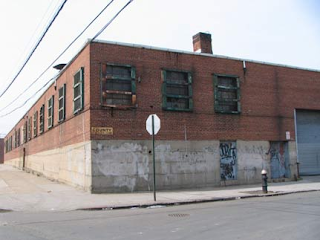Manufacturing – What’s Up with That?!

The mayhem that is manifesting in the manufacturing sector brings that familiar Saturday Night Live (SNL) skit to mind, What’s Up with That?! Between this week’s reported ISM data and Factory Orders, it’s no longer a forecast to say that manufacturing is missing something, unlike the skit. And given that China, India and the United Kingdom all reported less expansion in their manufacturing bases this week as well, I must say, what’s up with that?!
Our founder earned clients a 23% average annual return over five years as a stock analyst on Wall Street. "The Greek" has written for institutional newsletters, Businessweek, Real Money, Seeking Alpha and others, while also appearing across TV and radio. While writing for Wall Street Greek, Mr. Kaminis presciently warned of the financial crisis.
Relative Tickers: NYSE: BA, NYSE: RTN, NYSE: DGI, NYSE: GY, NYSE: GD, NYSE: GR, NYSE: NOC, NYSE: HON, NYSE: LMT, NYSE: COL, NYSE: LLL, NYSE: ERJ, Nasdaq: FLIR, Nasdaq: BEAV, NYSE: TDG, NYSE: SPR, NYSE: CAE, NYSE: ATK, NYSE: HXL, NYSE: TGI, NYSE: ESL, NYSE: MOG-A, NYSE: HEI, NYSE: TDY, NYSE: CW, Nasdaq: CVCO, NYSE: SKY, Nasdaq: NOBH, Nasdaq: PHHM, NYSE: MHK, Nasdaq: IFSIA, NYSE: AIN, NYSE: UFI, NYSE: ITW, NYSE: TYC, NYSE: CMI, NYSE: KUB, NYSE: IR, NYSE: DOV, NYSE: ITT, NYSE: FLS, NYSE: PLL, NYSE: DRC, NYSE: SPW, NYSE: GDI, NYSE: IEX, Nasdaq: NDSN, NYSE: GGG, NYSE: ATU, Nasdaq: MIDD, NYSE: ABB, NYSE: ETN, NYSE: NJ, NYSE: ROK, NYSE: AME, NYSE: RBC, NYSE: TMB, Nasdaq: WGOV, NYSE: CAT, NYSE: DE, NYSE: CNH, Nasdaq: JOYG, Nasdaq: BUCY, Nasdaq: AGCO, NYSE: EMR, NYSE: PH, NYSE: ROP, NYSE: PNR, NYSE: WM, NYSE: RSG, Nasdaq: FAST, NYSE: VMC, NYSE: MDU, NYSE: MLM, NYSE: OC, NYSE: VAL, NYSE: PCP, NYSE: X, NYSE: RS, NYSE: NVR, NYSE: DHI, NYSE: PHM, NYSE: TOL, NYSE: HOV, NYSE: CRH, NYSE: CX, NYSE: EXP, NYSE: FLR, NYSE: MDR, Nasdaq: FWLT, NYSE: ICA, NYSE: SWK, NYSE: TKR, NYSE: KMT, NYSE: LUK, NYSE: MAS, NYSE: WY, NYSE: PWR, NYSE: CBI, NYSE: EME, NYSE: SNA, NYSE: TTC, NYSE: GM, NYSE: F.
Manufacturing – What’s Up with That?!
 Some would have you believe that in actuality, the Factory Orders Report for April was not quite as bad as it appears. They’ll tell you that the 1.2% decrease in orders was helped along its downward way by a revision in March’s growth to 3.8%, from the initially reported 3.0% increase. But what matters is that April factory orders were less than March, period. Sure orders were 11.8% above April of 2010; the market pays closer attention to month-over-month change though. If she were a selfish woman, she would say, “What have you done for me lately.” And anyhow, other data points support the argument that the U.S. manufacturing sector is faltering.
Some would have you believe that in actuality, the Factory Orders Report for April was not quite as bad as it appears. They’ll tell you that the 1.2% decrease in orders was helped along its downward way by a revision in March’s growth to 3.8%, from the initially reported 3.0% increase. But what matters is that April factory orders were less than March, period. Sure orders were 11.8% above April of 2010; the market pays closer attention to month-over-month change though. If she were a selfish woman, she would say, “What have you done for me lately.” And anyhow, other data points support the argument that the U.S. manufacturing sector is faltering.Motor Vehicle Sales fell in May, missing analysts’ estimates, likely on higher gasoline pricing and a straggled consumer. The annualized rate of domestic motor vehicle sales dropped to 8.8 million, well short of the 9.7 million pace expected by the economists surveyed by Bloomberg. May was also deeply lower than April’s sales rate of 10.1 million. GM’s (NYSE: GM) deliveries dropped 1.2%; Ford’s (NYSE: F) deliveries fell 2.6%; and Toyota (NYSE: TM) and Honda Motors (NYSE: HMC) sales fell as well, though it dealt with special issues. According to IHS Automotive, 3 to 3.5 million in annualized sales may be lost or deferred to next year because of the catastrophe in Japan.
Clearly, Japan is having some impact on the global economy, which should be expected given the importance of its economy on the global scale. Japan is deeply integrated into the global economy, and its missing automotive part and car deliveries and electronics will reach broadly. But the depth of damage to the U.S. market seems to say there’s more to the manufacturing miss than Japan.
The most compelling argument was made by the Institute for Supply Management Wednesday, when it reported that its ISM Manufacturing Purchasing Managers Index (PMI) dropped precipitously to 53.5 percent, from 60.4 percent in April. That 6.9 point fall-off was hard to overlook, as it was also dangerously close to the 50 threshold that separates segment expansion from contraction. The May reading was the lowest in 12 months. Several of the qualitative responses of purchasing managers named inflation outright as a concern, and one manager in the machinery segment said they were more aware now of a potential softening in industry.
The 10.7 percentage point drop in the New Orders Index would seem to say the writing is on the wall. New Orders marked just one point above 50. Production dropped 9.8 percentage points, so the only real strength, if you can call it that, came from peripherals, including customer’s inventories. Yet every single component index reported slower expansion than in April. I suppose the only real good noise was that the pricing index fell 9 points, though at a mark of 76.5, it still measured significantly swift growth. Order backlogs, however, dropped 10.5 points, to 50.5. What’s up with that?!
The most obvious culprit is softened end demand for manufactured goods. Behind this would clearly be expensive gasoline prices, and the higher prices of all goods. Commodity price pressure has been effectively moving through the producer plateau on to the consumer level. We’ve seen it in consumer staple companies and retailers, raising prices due to higher petro-chemical component prices and even cotton prices. It’s being found across the board, with the Core Consumer Price Index making 0.2% month-over-month gains of late. This is the continuation of the trend that was becoming preeminent before the financial crisis staggered it.
It reminds me of an old argument I was making when I first started blogging, that there was a difference today versus years past with regard to food and fuel price change. I said there was a secular driver behind the current trend for higher fuel prices, the emergence of the developing world. This was no seasonal or production driven hike in food and petroleum. Rather, demand was ratcheting up for all goods and services. The monster we created in China was now alive and out of control, and it would destroy everything our civilization had come to rely on… especially price stability. Oh we thought she would solve all our profit margin problems when we moved our manufacturing base to China. What say you now American COOs?
Eventually the cost of living would price more and more of us out of consumption. The consumer mood of late certainly does not depict a happy shopper. So when people stop purchasing goods and services, none of us should be surprised to find recession again at the doorstep. The economy was vulnerable still to begin with, and then you go and let gasoline spike to $4? The government is debating the debt ceiling and Standard & Poor’s is threatening a relatively near-term downgrade of America. Wouldn’t you expect uncertainty to creep its way back into the minds of investors, confusing them as to what to do next, if not to take their money and run?
I’ll tell you what to do next. First of all, win the war in Libya as quickly and cleanly as possible. Take out the madman, and send your best political consultants over to help the Libyans draft a constitution and elect a government of some sort. Protect the oil and get oil and gasoline prices back down one way or another! Next, Congress needs to set a deadline for a debt deal that nowhere near flirts with the real deadline of the debt ceiling. They need to lock themselves up in a room and realize that this is not like every other political pressure cooker; the heat is much hotter, and we’ll all get burned if they push the political game too far this time around. That’ll do for starters, and oh yeah, that’s what’s up with that!

This article should interest investors in Boeing (NYSE: BA), Raytheon (NYSE: RTN), Digital Globe (NYSE: DGI), GenCorp (NYSE: GY), General Dynamics (NYSE: GD), Goodrich (NYSE: GR), Northrop Grumman (NYSE: NOC), Honeywell (NYSE: HON), Lockheed Martin (NYSE: LMT), Rockwell Collins (NYSE: COL), L-3 Communications (NYSE: LLL), EMBRAER (NYSE: ERJ), FLIR Systems (Nasdaq: FLIR), BE Aerospace (Nasdaq: BEAV), TransDigm (NYSE: TDG), Spirit Aerosystems (NYSE: SPR), CAE (NYSE: CAE), Alliant Techsystems (NYSE: ATK), Hexcel (NYSE: HXL), Triumph Group (NYSE: TGI), Esterline Technologies (NYSE: ESL), Moog (NYSE: MOG-A), Heico (NYSE: HEI), Teledyne (NYSE: TDY), Curtiss-Wright (NYSE: CW), Cavco (Nasdaq: CVCO), Skyline (NYSE: SKY), Nobility Homes (Nasdaq: NOBH), Palm Harbor Homes (Nasdaq: PHHM), Mohawk Industries (NYSE: MHK), Interface (Nasdaq: IFSIA), Albany International (NYSE: AIN), Unifi (NYSE: UFI), Illinois Tool Works (NYSE: ITW), Tyco International (NYSE: TYC), Cummins (NYSE: CMI), Kubota (NYSE: KUB), Ingersoll-Rand (NYSE: IR), Dover (NYSE: DOV), ITT Corp. (NYSE: ITT), Flowserve (NYSE: FLS), Pall (NYSE: PLL), Dresser-Rand (NYSE: DRC), SPX (NYSE: SPW), Gardner Denver (NYSE: GDI), IDEX (NYSE: IEX), Nordson (Nasdaq: NDSN), Graco (NYSE: GGG), Actuant (NYSE: ATU), Middleby (Nasdaq: MIDD), ABB (NYSE: ABB), Eaton (NYSE: ETN), Nidec (NYSE: NJ), Rockwell Automation (NYSE: ROK), Ametek (NYSE: AME), Regal Beloit (NYSE: RBC), Thomas & Betts (NYSE: TMB), Woodward Governor (Nasdaq: WGOV), Caterpillar (NYSE: CAT), Deere (NYSE: DE), CNH (NYSE: CNH), Joy Global (Nasdaq: JOYG), Bucyrus (Nasdaq: BUCY), Agco (Nasdaq: AGCO), Emerson Electric (NYSE: EMR), Parker Hannifin (NYSE: PH), Roper Industries (NYSE: ROP), Pentair (NYSE: PNR), Waste Management (NYSE: WM), Republic Services (NYSE: RSG), Fastenal (Nasdaq: FAST), Vulcan Materials (NYSE: VMC), MDU Resources (NYSE: MDU), Martin Marietta Materials (NYSE: MLM), Owens Corning (NYSE: OC), Valspar (NYSE: VAL), Precision Castparts (NYSE: PCP), United States Steel (NYSE: X), Reliance Steel (NYSE: RS), NVR (NYSE: NVR), DR Horton (NYSE: DHI), Pulte (NYSE: PHM), Toll Brothers (NYSE: TOL), Hovnanian (NYSE: HOV), CRH (NYSE: CRH), CEMEX (NYSE: CX), Eagle Materials (NYSE: EXP), Fluor (NYSE: FLR), McDermott International (NYSE: MDR), Foster Wheeler (Nasdaq: FWLT), Empresas ICA (NYSE: ICA), Stanley Black & Decker (NYSE: SWK), Timken (NYSE: TKR), Kennametal (NYSE: KMT), Leucadia National (NYSE: LUK), Masco (NYSE: MAS), Weyerhaeuser (NYSE: WY), Quanta Services (NYSE: PWR), Chicago Bridge & Iron (NYSE: CBI), EMCOR (NYSE: EME), Snap-on (NYSE: SNA), Toro (NYSE: TTC), GM (NYSE: GM) and Ford (NYSE: F).
Please see our disclosures at the Wall Street Greek website and author bio pages found there. This article and website in no way offers or represents financial or investment advice. Information is provided for entertainment purposes only.

Labels: Economic-Reports, Economy, Editors_Picks, Industrials, manufacturing



























